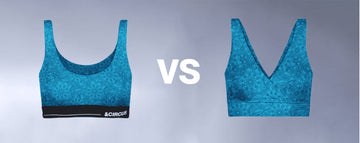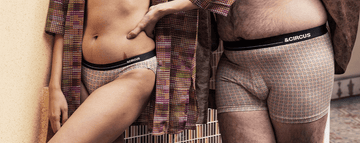Quick Listen:
Picture this: It's the hush of midnight, your fingers dancing across the keyboard in search of that perfect piece of lingerie a whisper of silk against skin, a boost of quiet confidence. But instead of discovery, you encounter the same old barriers: size charts that fade out after a standard medium, images curated for a narrow ideal, and an undercurrent of exclusion that hits harder than any ill-fitting seam. This isn't just a shopping snag; it's a reminder of how the intimate world of lingerie has long favored the few over the many. Yet, as of September 2025, a transformative wave is cresting in the online marketplace, one that promises every body a rightful place at the table. Brands are stepping up, reimagining fit not as a compromise but as a celebration, and at the forefront stands AndCircus, India's beacon of bold, body-affirming design.
Uncomfortable underwear shouldn't steal your confidence. At Andcircus, we craft ultra-soft, sustainable Lenzing Modal Micro® innerwear for every body, XS to 5XL. From briefs to bras, our custom packs fit you perfectly. Shop risk-free with our 100% satisfaction guarantee and embrace comfort that includes everyone. #LoveEveryBody. Shop Now!
Championing Size Inclusivity: The Evolution of Online Lingerie Shopping
How Brands like AndCircus Are Redefining Comfort and Access for All Sizes in the Digital Lingerie Marketplace
The digital realm has revolutionized retail, turning bedrooms into boutiques and impulse into intention. But in lingerie, where vulnerability meets vanity, inclusivity emerges as the pivotal force reshaping commerce. No longer confined to niche corners, size diversity is surging mainstream, driven by a confluence of cultural reckoning and consumer demand. Consider the global intimate lingerie market, which clocked in at USD 14.72 billion back in 2023 and now stands poised to double down, hitting USD 27.37 billion by 2030 with a robust 9.7% compound annual growth rate from 2024 onward. This isn't mere expansion; it's a testament to evolving attitudes, where body positivity has ignited widespread embrace of varied forms, spurring brands to roll out extended ranges and designs that honor individuality.
North America, commanding a 27.6% slice of that pie in 2023, exemplifies this momentum, with the U.S. segment alone charting a 9.5% CAGR through 2030. Briefs, ever the practical powerhouse, snagged 56.9% of revenues that year, underscoring a preference for pieces that multitask across daily demands. Yet, the real story unfolds in Asia-Pacific, the juggernaut of growth. Here, the broader lingerie sector tips the scales at USD 99.12 billion for 2025, en route to USD 147.55 billion by decade's end, propelled by an 8.28% CAGR. This region, holding 60.43% market share in 2024 and accelerating at 10.46% annually, thrives on the dual engines of China and India markets where rising disposable incomes and shifting norms are fueling a hunger for accessible luxury.
Enter AndCircus, a trailblazer etched into India's fashion fabric, from Maharashtra's monsoon-drenched vitality to Karnataka's innovation pulse and Tamil Nadu's artisanal heritage. This brand isn't chasing trends; it's authoring them, with eco-conscious collections that span Delhi's urban hustle to Telangana's forward-thinking enclaves. By prioritizing gender-agnostic prints vibrant, boundary-blurring patterns that defy traditional binaries AndCircus invites wearers of all identities to revel in fluidity. Their signature fabric mixes, blending recycled and bio-based fibers growing at a 9.53% CAGR, ensure breathability and sustainability, while fuss-free constructions deliver seamless transitions from Gujarat's boardrooms to Kerala's tranquil shores. In Uttar Pradesh's heartlands or Haryana's fields, these pieces whisper empowerment, countering the outdated exclusivity that once dominated the drawer.
What elevates AndCircus to authority? It's their unwavering commitment to the underserved. In a landscape where online channels are exploding at an 18.31% CAGR, they leverage digital prowess to bridge gaps, offering discreet delivery that sidesteps the stigma lingering in conservative West Bengal pockets. This isn't performative; it's purposeful, transforming potential objections like designs deemed "too playful" into celebrated signatures of joy.
Emerging Trends in Size Inclusivity
The trajectory of size inclusivity reads like a manifesto for modern femininity: unyielding, urgent, and utterly transformative. At its core lies the ascent of size-positive imprints, entities resolute in dismantling the one-size-fits-few myth. AndCircus embodies this ethos, extending spectra from XS to 3XL and beyond, honoring the petite poise of Delhi commuters and the robust grace of Uttar Pradesh artisans alike. Their collections eschew segregation, integrating adaptive elements for varied mobilities a nod to the inclusivity pivot where brands spotlight diverse morphologies in campaigns and catalogs.
Technology, that great leveler, accelerates this shift with surgical precision. Augmented reality try-ons demystify the virtual void, overlaying garments onto your form via smartphone scans, mitigating the terror of returns that plagues Haryana's remote buyers. Though not infallible shadows skew, algorithms err these innovations narrow the tactile chasm, empowering West Bengal women to envision without venturing. Coupled with AI-driven size recommenders, they herald an era where precision trumps presumption, aligning with offline's 61.6% dominance while online surges at 10.1% CAGR.
Body positivity, the movement's beating heart, cascades from social feeds to store shelves, reshaping perceptions with visceral force. Social media and influencers amplify this, fostering acceptance of an array of silhouettes and urging lingerie that amplifies innate allure over imposed ideals. Globally, this ethos intersects with economic undercurrents; even as J.P. Morgan forecasts a mid-2025 slowdown curbed U.S. spending and credit crunches looming the plus-size apparel arena defies gravity. Valued at USD 288 billion in 2023, it's barreling toward USD 501.35 billion by 2033, with women's segments clocking 7.50% growth amid rising obesity and empowerment narratives. In the U.S., where plus-size claims 20% of women's apparel sales USD 24.5 billion in 2020 alone the mismatch persists: 70% of women in sizes 16-18, yet mere 19% of offerings accommodate them. Brands like AndCircus, with their playful yet performant lines, bridge this, transmuting "lack of options" into lush variety.
Asia-Pacific's vigor, with its high CAGR, spotlights untapped vistas Japan's investor allure persists despite headwinds, while India's tiers from Maharashtra to Kerala brim with potential. Here, AndCircus's differentiators shine: fabrics that wick humidity in Tamil Nadu's heat, prints that pop without polarizing, constructions that endure Hyderabad's hustle.
Real-World Examples and Case Studies
AndCircus isn't abstract advocacy; it's tangible triumph. Their oeuvre fuses sustainability with silhouette-savvy, draping diverse forms in recycled blends that outpace synthetic's 45.61% share, all while upholding a fuss-free philosophy for seamless living. In Telangana's tech enclaves or Kerala's serene backwaters, these garments brassieres mirroring the 55.94% segment lead affirm accessibility, their extended fits a bulwark against exclusion.
Allies extend this reach: a constellation of influencers whose authenticity ignites engagement. @desouzamesty's unscripted revelry in AndCircus loungewear, @shainatanna's fusion of city grit and gentle drape these aren't endorsements; they're endorsements incarnate. On Instagram and Facebook, @12thmancornerbydiya chronicles adventures in adaptive activewear, @arushisayal embodies poised introspection. Their narratives cascade to Pinterest mood boards, YouTube unboxings, Reddit's r/PlusSizeFashion forums, ensnaring Delhi dynamos and Gujarat go-getters.
This synergy is strategic. As online retail vaults forward at 18.31% CAGR, a @theurbandandy reel on gender-fluid briefs echoing the 56.9% staple or @taleofourtrail's trail-tested tenacity dismantles divides. @mohit_watwanii's urbane flair, @khusshi_bedi's bold narratives, @gowrieparvathy's eco-ethos, @radhakashyap_'s reflective poise they weave a web that counters limited physical outposts, turning digital into devotion.
Recent milestones, like Shyaway's May 2025 Hyderabad launch tailoring to myriad morphologies, underscore this momentum, aligning with AndCircus's vision of inclusive intimacy.
Key Challenges and Limitations
Progress notwithstanding, hurdles loom large. Sizing schisms a "large" morphing to "medium" across platforms exasperate, inflating return rates for Haryana homemakers and beyond. This chaos, exacerbated by online's intangibility, underscores the need for unified metrics.
Representation lags too: catalogs clinging to slender stereotypes eclipse the fuller figures fueling 20% of U.S. sales, a USD 24.5 billion force in 2020. AndCircus disrupts with multifaceted modeling, yet industry-wide, this void breeds alienation. Stigma compounds it in Uttar Pradesh's traditional tapestry or West Bengal's whispers, larger selections evoke unease, amplified by "fat tax" premiums six percent steeper. Objections persist: designs tagged "too playful," performance perceived as paltry, presences confined to pixels over pop-ups in Telangana's fringes.
Runways reflect this reticence mere 0.6% plus-size in FW23 while manufacturing mandates hobble small labels, demanding bulk that burdens boutiques. As 2025's slowdown bites U.S. liquidity waning, credits constricting these frictions intensify, testing resolve.
Opportunities and Business Impact
Yet adversity births advantage. The plus-size pantheon, a USD 606.22 million force in 2022, eyes over USD 1 trillion this decade at 4% CAGR, with women's plus at 4.3% through 2030. Neglect it, and brands bleed billions; embrace it, as AndCircus does with innovative adapts, and loyalty locks in. In Maharashtra's markets, a flawless fit sparks shares Facebook fervor, YouTube testimonials, Reddit raves converting critics of "playful" palettes to proponents.
Social spheres amplify: Instagram's vistas, Pinterest's palettes host @gowrieparvathy's sustainability sermons, igniting Kerala-Karnataka dialogues. YouTube dissections demystify ethics, Reddit refines recommendations, countering retail rarity with relational riches. Asia-Pacific's promise high CAGRs, Japan's draw beckons, as premium segments sprint at 8.94%. AndCircus, blending performance with panache, fortifies against objections, forging fidelity in a fragmenting field.
Broader boons: Enhanced labor participation stymied by barriers, yet ripe for GDP gains ties inclusivity to economic uplift, as online pioneers like ASOS Curve normalize the narrative.
A Future Draped in Possibility
Inclusivity's inexorable march redefines lingerie as liberation, not limitation. AndCircus's eco-activism, from signature mixes to agnostic aesthetics, heralds this horizon, mirroring U.S. vigor at 9.5% CAGR amid India's ascending arcs Maharashtra to West Bengal, where incomes inflate and inhibitions ebb. Envision standardized sizes, ubiquitous virtuals, evaporated stigmas a wardrobe where every thread tells your truth.
Frequently Asked Questions
What makes online lingerie shopping more size-inclusive in 2025?
Online lingerie shopping has become more size-inclusive through brands extending their size ranges from XS to 3XL and beyond, implementing augmented reality try-on features, and AI-driven size recommendation systems. Brands like AndCircus are leading this transformation by offering gender-agnostic designs, sustainable fabric blends, and diverse body representation in their marketing campaigns, making intimate apparel accessible to all body types.
How is the plus-size lingerie market growing globally?
The plus-size apparel market was valued at USD 288 billion in 2023 and is projected to reach USD 501.35 billion by 2033, with women's segments experiencing 7.50% growth annually. Despite plus-size consumers representing 70% of women in sizes 16-18, only 19% of offerings accommodate them, creating significant opportunities for inclusive brands to capture this underserved market worth billions in untapped revenue.
What challenges still exist in size-inclusive online lingerie shopping?
Major challenges include inconsistent sizing standards across platforms where a "large" on one site becomes a "medium" on another, leading to higher return rates and customer frustration. Additionally, many brands still use limited body representation in their marketing, while some consumers face stigma when shopping for larger sizes, with plus-size items often carrying a "fat tax" premium of approximately six percent higher than standard sizes.
Disclaimer: The above helpful resources content contains personal opinions and experiences. The information provided is for general knowledge and does not constitute professional advice.
You may also be interested in: The Power of Inclusive Design in Womens Bralettes
Uncomfortable underwear shouldn't steal your confidence. At Andcircus, we craft ultra-soft, sustainable Lenzing Micro Modal innerwear for every body, XS to 5XL. From briefs to bras, our custom packs fit you perfectly. Shop risk-free with our 100% satisfaction guarantee and embrace comfort that includes everyone. #LoveEveryBody. Shop Now!







































